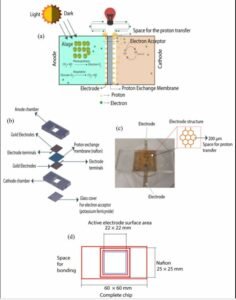Researchers from Concordia University have designed a novel process to generate power using the electrons created by algae during photosynthesis. The team also notes that their power-generating system doesn’t produce any emissions other than water while simultaneously consuming carbon from the atmosphere like many other plants, making it even better than carbon-neutral methods used to generate power.
Although the Concordia research team’s device, a micro photosynthetic power cell, currently offers a very modest power output and only exists in a lab setting, the scientists behind its creation believe future design improvements, including the use of AI, could increase the algae-powered fuel cell’s ability to generate power for low-energy applications like low-power Internet of Things sensors.
“The idea of the micro photosynthetic power cell is to extract electrons produced through the process of photosynthesis,” explained Kirankumar Kuruvinashetti, a PhD 20 at Concordia and now a Mitacs postdoctoral associate at the University of Calgary, in a press release announcing the team’s work. “Photosynthesis produces oxygen and electrons. Our model traps the electrons, which allows us to generate electricity.”
Using Algae to Generate Power and Clean the Environment
To test their concept of generating power from the photosynthesis of living algae, Kuruvinashetti and the rest of the Concordia research team decided to build a custom-made micro photosynthetic power cell that could tap into the electron-generating power of algae. This meant creating a two-chambered cell that would work more or less like a traditional power cell. In their design, one chamber would contain the fuel cell’s cathode, while the other would contain the cell’s anode. Placed between the two cells is a honeycomb-shaped proton exchange membrane which captures the protons created by photosynthesis.
The team also fabricated a pair of customized microelectrodes and placed one in each chamber. If their system worked correctly, these electrodes would harvest the electrons generated during the algae’s photosynthesis process and then convert them to usable electrical power.


“Just like humans, algae are constantly breathing — but they intake carbon dioxide and release oxygen. Due to their photosynthesis machinery, they also release electrons during respiration,” explained PhD candidate and paper co-author Dhilippan Panneerselvam. “The electricity generation is not stopped. The electrons are continuously harvested.”
Next, the researchers filled the anode chamber with a two-millimetre aqueous solution. The cathode chamber was then filled with potassium ferricyanide, a type of electron acceptor. A sample of living algae was also placed in each chamber, and the device was ready to go.
As hoped, their system began to generate power immediately. Unfortunately, it was at a very low voltage. Fortunately, the team says they already knew it would be very low, as the laws of thermodynamics limit exactly how many useable electrons can be produced by a photosynthetic reaction.
According to the press release announcing the system, which uses algae to generate power, “the maximum possible terminal voltage of a single micro photosynthetic power cell is only 1.0V.”
System Uses no Hazardous Materials and is Biocompatible
In the research published in the journal Energies, the team behind the system that uses algae to generate power says they believe their product could one day be scaled up to power even more energy-hungry devices. In fact, their current power cell is extremely small, measuring only two centimetres by two centimetres by four millimetres. It also works without the need for direct sunlight, increasing its possible applications.
As previously noted, the team says their power cell has several environmental advantages. For example, it does not use hazardous gases or toxic microfibers like those used in the construction of photovoltaic cells. It also produces oxygen and water while consuming carbon dioxide, making it an extremely clean way to generate energy.
“So more than being a zero-emission technology, it’s a negative carbon emission technology,” Kuruvinashetti explained. “It absorbs carbon dioxide from the atmosphere and gives you a current. Its only byproduct is water.”
Finally, the team says that unlike computer chips, which are hard to manage after their life cycle is complete, their power cell uses biocompatible polymers. According to Muthukumaran Packirisamy, a professor in the university’s Department of Mechanical, Industrial, and Aerospace Engineering and the paper’s corresponding author, this means that the whole system “is easily decomposable and very cheap to manufacture.”
“This technology has the potential to be a viable, affordable and clean power source in the future,” the press release explains. That same release also notes that “configured correctly, these cells can generate enough energy to power low- and ultra-low-power devices such as Internet of Things sensors.”
Christopher Plain is a Science Fiction and Fantasy novelist and Head Science Writer at The Debrief. Follow and connect with him on X, learn about his books at plainfiction.com, or email him directly at christopher@thedebrief.org.

